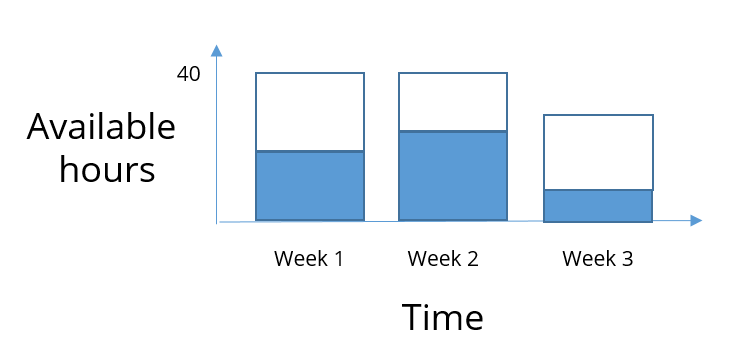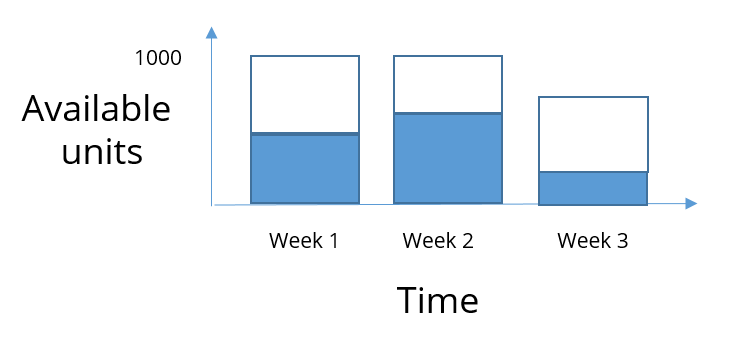Resources
Resources represent capacity. They represent a machine, a group of machines, an operator, a group of operators, or some logical capacity constraint.
Operations will consume capacity using operation resources.
Different types of resources exist:
- A default resource is constrained with a maximum load size. The resource size defines how many operations that can use the resource in parallel.
E.g. A resource that can run 1 job at a time.

- A bucketized resource is constrained by the amount of resource-hours per time bucket. The detailed scheduling of the resource within this bucket isn’t considered.
E.g. A resource that has 40 hours available per week.

- A bucketized resource is constrained with a maximum load quantity per time bucket.
E.g. A resource that can produce 1000 units per week.

- An infinite resource has no capacity limit.This can be modeled by setting the “constrained” field to false or (deprecated) by setting the resource type to “infinite”.
You can see each resource type in action in this example.
Field |
Type |
Description |
|---|---|---|
name |
non-empty string |
Unique name of the resource.
This is the key field and a required attribute.
|
description |
string |
Free format description. |
category |
string |
Free format category. |
subcategory |
string |
Free format subcategory.
If this field is set to ‘tool’, the field ‘tool’ will
automatically be set to true.
|
owner |
resource |
Resources can be organized in a hierarchical tree.
This field defines the parent resource.
When an operation loads a resource which has members, the
planning algorithm will select one of the child resource.
|
members |
list of resource |
Resources can be organized in a hierarchical tree.
This field defines a list of child resources.
|
location |
location |
Location of the resource.
Default is null.
The working hours and holidays for the resource are taken
from the “available” calendar of the location.
|
constrained |
boolean |
This flag controls whether whether or not this resource is
planned in finite capacity mode.
The default is true, except for resources of type infinite.
|
maximum |
double |
Defines the maximum size of the resource.
The default value is 1, i.e. a resource that can handle
1 operation at a time (provided of course that this
operation requires 1 unit on the resource).
A problem is reported when the resource load exceeds
than this limit.
This field is ignored on resource of type buckets and infinite.
|
maximum_calendar |
calendar |
Refers to a calendar storing the available capacity.
Use this field when the resource size is varying over time.
If this field is populated, the field maximum is ignored.
On resources of type buckets this calendar defines the
time buckets as well as the maximum quantity per time bucket.
This field is ignored on resources of type infinite.
|
available |
calendar |
A calendar specifying the working hours for the resource. The working hours and holidays for a resource are calculated as the intersection of:
Default is null. |
efficiency |
double |
The efficiency of this resource, expressed as a percentage. The manufacturing order duration will be extended or shrunk when this field is different from 100. The default value is 100. |
efficiency_calendar |
double |
Refers to a calendar storing the resource efficiency when it varies over time. If this field is populated, the field efficiency is ignored. |
cost |
double |
The cost of using 1 unit of this resource for 1 hour. The default value is 0. |
maxearly |
duration |
Time window before the ask date where we look for available capacity. The default value is 100 days. |
setup |
non-empty string |
The name of the current setup of the resource, ie the setup of the resource at the start of the planning horizon. |
setupmatrix |
setupmatrix |
The name of the setup matrix which specifies the changeover times between setups. |
hidden |
boolean |
Marks entities that are considered hidden and are normally not shown to the end user. |
tool |
boolean |
A flag to resources that represents tools. Tools represent
holders, fixtures or moulds that are attached to a
manufacturing order over a number of steps in a routing.
The same tool needs to stay attached to all steps in the
manufacturing routing.
Default is false.
This field is only visible in the planning engine. In the
user interface you use the subcategory field to set this
field to true.
|
Default resource
A default resource is constrained with a maximum load size. The resource size defines how many operations that can use the resource in parallel.
For detailed planning and scheduling this is the most suitable resource type. E.g. A resource that can run 2 jobs at the same time.
No fields are defined in addition to the ones listed above.
Time buckets resource
A resource of this type is constrained by the amount of resource-hours per time bucket. E.g. A resource that has 40 hours available per week.
The available time per capacity bucket is computed using:
its size, as specified by the maximum or the maximum_calendar field.
its working hours, as specfied by its available calendar field and its location’s available calendar field
A manufacturing order will consume the required capacity in the capacity bucket where it starts.
For master planning and rough cut capacity planning this is most suitable resource type. Detailed scheduling of the operations within the time bucket isn’t considered useful in this type of plan.
Quantity buckets resource
A resource of this type is constrained by a maximum quantity per time bucket. E.g. A resource that can produce 1000 units per week
For master planning and rough cut capacity planning this is most suitable resource type. Detailed scheduling of the operations within the time bucket isn’t considered useful.
The maximum_calendar field defines the time buckets, as well as the available quantity per time bucket.
A number of specialized operationresource subclasses exist to select in which bucket the capacity needs to be consumed: at the start of the operation, at the end of the operation or somewhere between the start and end.
Infinite resource
An infinite resource has no capacity limit. It is useful to monitor the loading or usage of a resource without constraining the plan.
The fields ‘maximum’ and ‘maximum_calendar’ are unused for this resource type.
